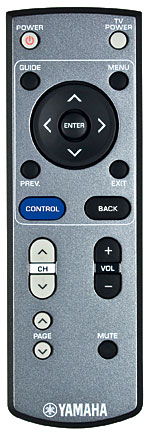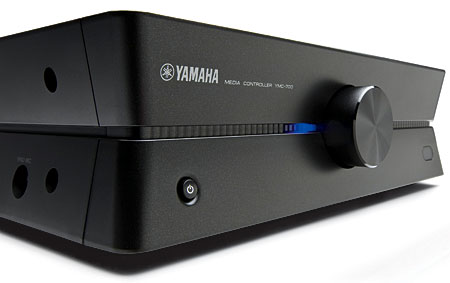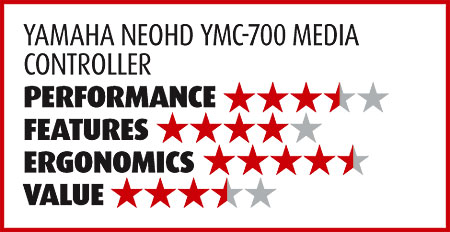Yamaha neoHD YMC-700 Media Controller Page 2
I avoided Yamaha’s proprietary YPAO auto setup and room correction routine, partly because I’m stubbornly old-fashioned and partly because I like the sound of my room. But the folks who are likely to buy this product would probably be happy to use the easier YPAO option.
 A final step remained. The neoHD communicates with Windows through Windows Media Player 11. (The menu also lists a MAC address filter for users who require manual configuration.) I selected the Library tab, then the Media Sharing menu item, found the YMC-700—which indicated that the network connection was up and running—and allowed it.
A final step remained. The neoHD communicates with Windows through Windows Media Player 11. (The menu also lists a MAC address filter for users who require manual configuration.) I selected the Library tab, then the Media Sharing menu item, found the YMC-700—which indicated that the network connection was up and running—and allowed it.
Associated gear included Paradigm Reference Studio 20 v4 speakers running full range, a Panasonic DMP-BD35 Blu-ray player, the Netgear WGR614 router that I mentioned above, a Lenovo ThinkCentre A61e PC running Windows XP, an Iomega 500-gigabyte external hard drive, and a USB thumb drive. All movie selections were Blu-ray Discs with Dolby TrueHD lossless soundtracks.
You Pays Your Money, and You Takes Your Choice
When I booted up the neoHD, the screen was blank for 10 seconds. Then a Please Wait message appeared. After another 10 seconds, the main menu came up. The menu’s choices include Watch TV/Movies, Listen Music/Radio, Play Photos/Games, and (in tiny type) Setup. There are no dedicated source-select buttons on the remote, so this graphic user interface is the only game in town. It’s good-looking and easy to use. To start my movie sessions, I picked Watch TV/Movies. This brought a further choice between Movie or iPod. I picked Movie, and my Blu-ray player’s familiar blue screen saver swam onto the screen.
I’ll cut to the chase. Although Yamaha doesn’t disclose a rated power spec—see HT Labs Measures—there was enough power to run my Paradigms at a satisfying (moderate) volume. The leading edge of the midrange was well defined and a little hard. Highs were neither rolled off nor especially clean. Bass was minimal.
This was decent, adequate, entry-level receiver sound. It worked well for dialogue, but the loudest effects could be uncomfortable. This kind of receiver—scratch that, all receivers—would benefit from a low-volume listening mode such as Dolby Volume, THX Loudness Plus, or Audyssey Dynamic Volume/EQ. This is a windmill I am increasingly inclined to tilt at. Consumers need this feature in any receiver.
Paycheck ushers Ben Affleck and Uma Thurman through a scenario about a scientist who develops a terrifying new technology and agrees to have his mind erased of all memories of it. Any relation to the team who developed the neoHD was purely coincidental. The loudest synthetic and ballistic effects were a little uncomfortable. But the soundfield was decently proportioned, and I had no trouble catching the words.
The Cell 2 is another head trip. This time, the head belongs to a clairvoyant who inhabits the mind of a serial torturer and killer. The killer specializes in flat-lining his victims, resuscitating them, subjecting them to further suffering, and then killing them again, but only after he inanely talks them half to death. It seemed like a lot of trouble for not much entertainment. The dialogue was flatly recorded—as well as flatly written and flatly acted—and it was a cinch for the neoHD. Effects included creaks and whines that escalated to standard horror-movie crescendos, which (this time) were easier to take.

Hotel for Dogs—the name sums up the preposterous comic scenario—reinforced my now solid impression that the neoHD’s top end was neither vague nor clean. Heartwarming oboes leapt out of the score of this movie’s distinctive blend of doggie humor and contraption humor. This was the gentlest of the soundtracks (and stories), and in many ways, it was the most enjoyable.
Into the Music and Picture Menus
When I selected Listen to Music/Radio from the main menu, the next menu offered a choice of CD, Rhapsody, FM Radio, iPod, Net Radio, USB, and (moving to the next menu) PC Content and Bluetooth. Each choice was festooned with an attractive color graphic. With this kind of product, such little touches are pleasing.
I selected PC Content and saw the Lenovo ThinkCentre come up. When I selected it, I saw an assortment of music-access options that more or less mirrored the Windows Media Player. There were a few others, but the PC folder where I keep most of my music—labeled Music—wasn’t among them initially. The neoHD echoes WMP and Windows nomenclature closely, but it won’t show user-named folders unless you specifically enable them in WMP. That’s what I did, but it might be simpler to keep your music folders in My Music or on the desktop, where Microsoft and Yamaha would expect you to keep them.
The neoHD accepts thumb drives through its USB port, as long as they are formatted in FAT16 or FAT32, as opposed to NTFS. If you plug in an NTFS drive, you’ll get a Not Supported error message. If you’re not sure how your drives are formatted, go to My Computer, right-click the drive letter, and click on Properties. Most thumb drives are FAT. Theoretically, you might also plug a FAT-formatted external hard drive into the USB port. However, a heavily loaded one would send the neoHD into a prolonged indexing frenzy, so I don’t recommend it. The best way to plug in an external hard drive is via the PC. Once you’ve enabled it in the Windows Media Player, WMP will do the indexing and it won’t matter whether the drive is FAT or NTFS.
It wasn’t hard for me to find a FAT drive. I have a whole baggie full of USB thumb drives, thanks to generous manufacturers who distribute press materials on them. One of them, nostalgically labeled with the HD DVD logo, was quickly recognized when I plugged it directly into the neoHD. As fate would have it, I had just downloaded Travis & Fripp Live at All Saints Church, Broadchalke, United Kingdom from DGMLive and copied the MP3 files (192 kbps) to the stick. Now I was at liberty to enjoy the music.
Theo Travis plays flute and soprano sax, with Fripp on guitar synthesizer, in partly improvised duets. The church ambience softened the neoHD’s hard edge, except during moments where the guitar synth had significant amounts of high-volume treble content. While the music played, I hit the remote’s blue Control button, and some options came up, including Audio Adjustment (which includes bass, treble, and sub level) and DSP Program (Movie, Entertainment, Live Music, Music Enhancer, All Channel, and All Channel Stereo). If I were developing a long-term relationship with this product, I’d probably use a treble cut across all signal sources.
I found a modest connectivity feature that Yamaha’s manual doesn’t mention: iPod connectivity without a dock. I plugged my iPod, with the Apple-approved iPod/USB cable, directly into the USB jack on the neoHD’s back panel. To get into the iPod, I picked Listen to Music/Radio, USB, and then was confronted with the following four cryptic choices: Calendars, Con- tacts, iPod Control, and Notes. When I chose iPod Control, the resulting choices were Accessories, Artwork, Device, iTunes, and—finally, the payoff—Music. The disappointment that followed will be familiar to any Windows user who has tried to access music on an iPod without going through iTunes. The folders that came up were titled F00, F01, and F02. Although I could play the music in these folders, the files had similarly cryptic four-letter names that had nothing to do with the song titles. So essentially this unadvertised feature is a giant shuffle mode. If you want to actually pick songs off an iPod, you’ll have to pay the extra cost of a dock.
Old-fashioned listener that I am, I played a disc. While I knew the Blu-ray player would appear under the menu’s Watch TV/Movies option, I wondered what would happen if I got literal and accessed the player via Listen Music/Radio. The neoHD did not disappoint—it located the BD player as a CD player. I popped in James Galway’s Celebrating 70: A Collection of Personal Favorites. Track one was “Spring” from Vivaldi’s Four Seasons. The Red Priest scored this beloved work with light instrumental textures that played to the neoHD’s strength. It sounded very good, and the flute wasn’t particularly shrill on most selections.
The greatest pleasure I got from the neoHD was Internet radio. It worked immediately and provided a larger music library than a mere mortal could possess.
I also used the Play Photos/Games menu option to view some vacation pictures. The neoHD lets you set the slide show’s time between pictures anywhere from 2 to 20 seconds. It took 8 seconds to manually step through the pictures. The resolution was well below what my 7-megapixel camera is capable of. Worse, everything appeared in a squarish (and therefore vertically stretched) aspect ratio. Some people are immune to aspect ratio distortions, but I find them disorienting, so the neoHD’s photo feature was useless to me.
Yamaha’s neoHD YMC-700 media controller is the first of its kind, at least from this mainstream A/V receiver maker, so most of its quirks are forgivable. It successfully rethinks how a receiver should operate and emphasizes content rather than technology. The media-savvy receiver (oops, controller) is a train of thought that’s worth pursuing.






























































